It’s become a cliché among critics and fans when describing certain movies, often ones that develop a cult-like following over the years thanks to HBO, VHS, and more recently, streaming services such as Netflix, but if any motion picture ever fit the bill of the ol’ “A movie like this would never get made today”—it’s the sequel to Evil Dead 2, officially titled Army of Darkness.
Released in the United States in February of 1993, Army of Darkness, the Sam Raimi-directed, Bruce Campbell-starring swashbuckling splatstick spectacular fizzled at the box office, only to find a much more robust second life, resurrected on VHS, and then on numerous DVD incarnations throughout the format’s boom period of the early to mid-aughts. If you collected DVDs and were a fan of the chainsaw-wielding, boom-stick blasting, wisecracking cartoon character come-to-life named Ash (our miserable, cowardly hero played straight by the now iconic square chinned Campbell), odds are you owned one, if not multiple versions of Army of Darkness (not to mention the original Evil Dead and Evil Dead 2) on DVD and/or Blu Ray.
Army of Darkness is a direct sequel to Evil Dead 2, with Ash being sucked back in time into the Dark Ages, where he falls from the sky (along with his ’73 Oldsmobile) and must do battle with an army of the dead, known as “Deadites,” retrieve the Book of the Dead, the “Necronomicon”, and get back to his girlfriend Linda (played in this installment by beauty Bridget Fonda. The actress was a legitimate fan of Evil Dead 2 and sought the part out, despite it being a very small role at a time when her career was beginning to blossom amidst a buzz around Tinsel Town, with memorable roles in Single White Female in 1992, the Seattle grunge music-centric Singles in 1992, and the Hollywood remake of Luc Besson’s La Femme Nikita, the pointless Point of No Return in 1993).
Army of Darkness fought an uphill battle straight out of the cemetery gates. First off, it was not heavily promoted as the third part in the Evil Dead trilogy. Studio execs didn’t want to scare off any potential ticket sales from audience members who may not have seen the first two films, even though Army of Darkness works fine as a standalone piece thanks to crafty recapping in the storytelling. In fact, almost all of the promo spots that would have aired as television commercials at the time to promote the film’s release reference the film as being from Sam Raimi, “director of Darkman” (which itself, at the time, had not exactly made Raimi a household name). There was no mention of Evil Dead or Evil Dead 2. The film wasn’t marketed anywhere in name as Evil Dead 3: Army of Darkness, or even under another title that director Raimi had toyed with, Medieval Dead.
While in high school, I saw full color ads running in comic books for the release of Army of Darkness. I had yet to see Evil Dead 2 at that point in my life, but I was extremely familiar with the poster art for that film. I remember going to the corner Convenient store and seeing a small wall of VHS titles for rental, and for years I was both terrified and mesmerized by the box art of Evil Dead 2, with that chilling skull with the human eyeballs peering at me, daring me to a staring contest that I never ever won.
It was one New Year’s Eve night that a few of my high school buddies invited me over to watch some movies. Their parents had rented them tapes to keep them occupied over the two-week Christmas break. They popped in Army of Darkness, informing me that the events of the film took place following Evil Dead 2, assuring me that I would have no problem being brought up to speed with the plot (and let’s be honest, we’re not exactly talking Game of Thrones here).
Within minutes of the movie starting I knew I had nothing to be scared of, as the tone of the film has an undeniable goofy charm about it, relying heavily on special effects from F/X masters KNB, who paid heavy homage to Ray Harryhausen and Jason and the Argonauts with the marching skeletons, and the deadpan delivery and physical humor of Bruce Campbell (perfecting his “Three Stooges” routines that had also been on display in Evil Dead 2). In many ways, it’s a very distant cousin of Abbott and Costello meet Frankenstein (1948), reminiscent of the horror blending with humor that makes it a perfect entry point for someone such as myself, who had yet to muster up the courage to make the full transition to horror junkie. This would come just a few short years later when I dove head first into the deep end of that bloody pool in the horror section of the local Blockbuster Video).
So it’s a bit puzzling to learn that Army of Darkness initially got branded with the dreaded NC-17 rating from the MPAA when it was first submitted for approval. I’m not even certain the film needs the R-rating these days, but things were different back in 1993. It’s been suggested that perhaps the film was slapped with the initial NC-17 rating as a bit of revenge from the ratings board, who weren’t exactly pleased with Raimi’s handling of Evil Dead and Evil Dead 2 (the original entry in the series was rated X in 1981, with Evil Dead 2 having been released unrated, so as to not compromise with the MPAA ratings board, which was archaic and often arbitrary and inconsistent in its decisions even then).
Many consider the original Evil Dead a horror movie, while Evil Dead 2 strays very far into the comedy genre, with Army of Darkness being a good ol’ fashioned fantasy slash adventure movie, somewhat out of fashion in 1993. It’s possible the schizophrenic tonal shifts from each subsequent film contributed to the lackluster box office performance of Army of Darkness, budgeted somewhere between $11-13 million, and likely just breaking even in 1993.
Raimi himself was somewhat critical of the third act of Army of Darkness, saying he lost a little bit of interest in Ash when the character showed that he could take control and lead a battle against the army of deadites. Raimi preferred Ash to be incompetent and miserable, and has said that if he was true to the character, if Ash was facing the end of the world, he wouldn’t be getting ready for battle, but would likely be on the prowl for a new girlfriend for a final one night stand. Much of this is covered on the wonderful new documentary “Medieval Times: the Making of Army of Darkness”, included in the very affordable, very comprehensive 3 disc Collector’s Edition Blu Ray release of Army of Darkness, released with much love and care by Scream Factory in 2015. Yes, this version is worthy of your money, as it includes the aforementioned documentary, along with the Theatrical Version of the film (with a running time of 81 minutes), the Director’s Cut (with a running time of 96 minutes and a vastly different ending than the version you’ve seen at the theater or on the original VHS release), and a new 4K scan from the inter-positive of the International Cut (88 minutes), not to mention bells and whistles from previous releases such as commentaries, behind the scenes footage, even the television version for good measure.
The trilogy, in particular Army of Darkness, seemed to grow in popularity exponentially with each passing year, and fans demanded to know what their reluctant hero was up to. There would be merchandise like a video game and comic books furthering Ash’s adventures to hold the fans over, but whether you were a fan of the media tie-ins or not, there was no denying that nothing could replace seeing Bruce Campbell suit up with the chainsaw prosthetic and his patented delivery of classic one-lines like “Groovy”, “Gimme some sugar, baby” and “Hail to the king, baby.”
There’s another famous saying that goes “This ain’t show-friends, it’s show-business”, and even though Raimi and Campbell were friends prior to their Evil Dead trilogy, in the time since the release of Army of Darkness, the director would become a major power player, first establishing himself outside horror with the quirky Sharon Stone-vehicle The Quick and the Dead (released in 1995, and yes, Raimi’s lucky ’73 Oldsmobile makes a cameo in that film too, even though it’s Raimi’s riff on the Spaghetti Western genre—trust me, the car is in there), the critically praised A Simple Plan, released in 1998, working with Bridget Fonda here again), and then tackling the blockbuster Spider-Man franchise (another trilogy for Raimi, this one starring Tobey Maguire in the lead role, with films being released rapidly in 2002, 2004, and 2007).
Bruce Campbell, the king of comic-book and horror convention Q&As at this point, was hounded and asked relentlessly about the chances of a fourth entry into the Evil Dead series. There was no denying that there was money being left on the table, and this was show-business after all, but he would often reply only half-jokingly that his friend Sam was a little too in demand these days to return to his horror movie roots and with each passing year, Evil Dead 4 seemed less and less likely.
Fans were teased a bit when Raimi did, in fact, go back home to horror in 2009 with Drag Me to Hell, proving he still had the chops. More than anything, this was a palate cleanser for Raimi, who was coming off the exhausting Spider-Man shoots, before venturing back into tentpole city with Oz the Great and Powerful (2013).
Not only did Oz seem like a stake through the heart for fans that had been holding out, but the same year saw a remake of Evil Dead, which had little to nothing to do with the original franchise, though Raimi served as producer.
Just as fans were ready to throw in the towel, Internet rumors surrounding something new in the original Evil Dead universe began to take shape again. Was this just Bruce Campbell being playful after answering that burning question for the billionth time of “Will there or won’t there be an Evil Dead 4?”
Yes.
And no.
There would be no Evil Dead 4, per se, but fans would be getting even more than they could have anticipated, with Campbell reprising his role as Ash, this time in the ongoing cable series Ash vs. Evil Dead, proof that in Ash’s universe, and in Hollywood, the dead are never truly dead.

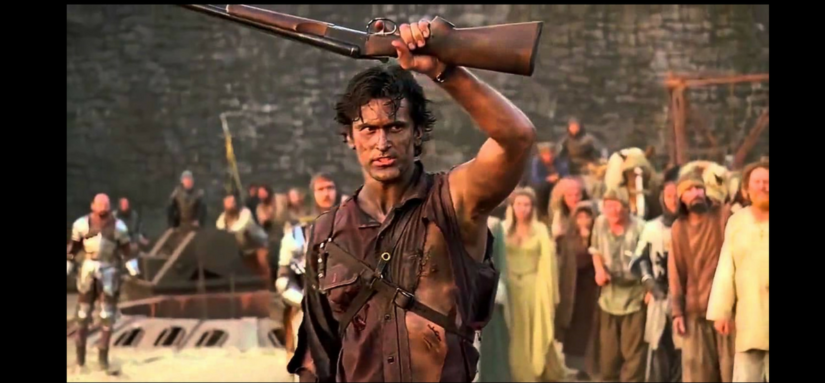
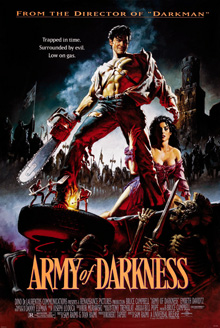
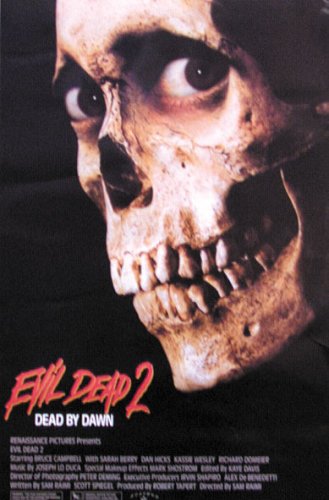
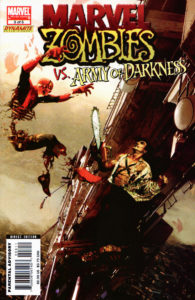
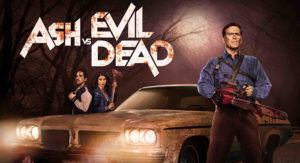
Comments are closed.